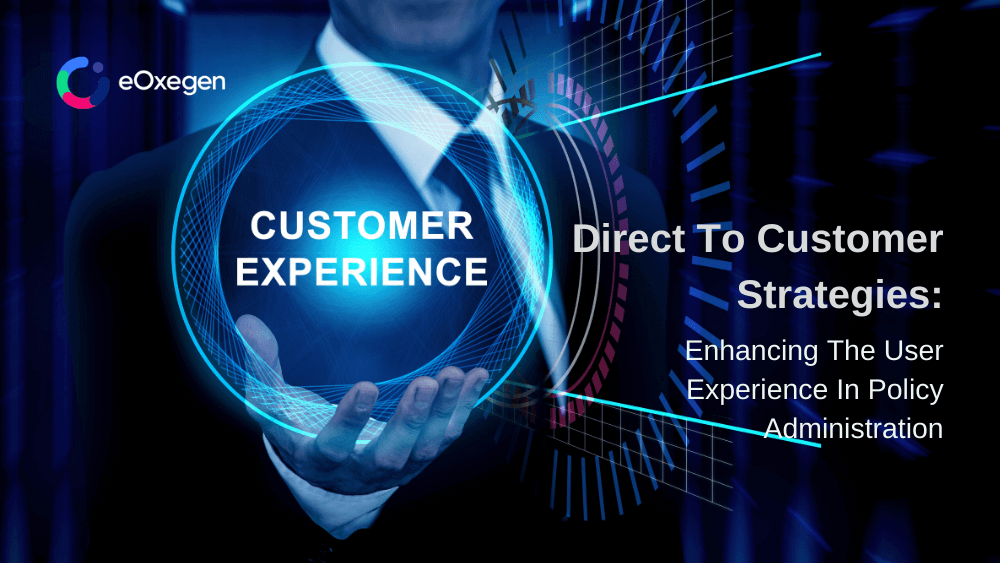Direct To Customer Strategies: Enhancing The User Experience In Policy Administration
6 March, 2024

Any insurance company, broking firms, or agency can benefit greatly from building a devoted and satisfied policyholder base. Currently, offering top-notch customer service is essential; your clients demand it.
The average customer spends 67% more in the third and fourth months of their engagement than in the first six. Moreover, according to 33% of Americans, a single negative customer experience will cause them to consider switching insurance companies.
When it comes to pricing, keeping existing customers is much less expensive than gaining new ones. Insurance firms frequently spend five times as much on new business acquisition as retention. So why don't more insurance companies focus on offering their customers an amazing experience right away?
Role of Insurance Policy Administration Systems
Insurance policy administration systems are essential tools that enable insurers to efficiently manage policy lifecycle processes, from policy issuance and underwriting to billing and claims processing. These systems automate and streamline administrative tasks, reducing manual intervention, minimizing errors, and improving operational efficiency. Additionally, an insurance policy administration system provides policyholders with self-service capabilities, empowering them to manage their policies independently and conveniently.
Ways to Build a Better Customer Experience Through D2C Strategies in Insurance
Direct to customer (D2C) strategies in insurance refer to the approach of selling insurance products directly to consumers without the involvement of intermediaries, such as agents or brokers. With the rise of digital technologies and changing consumer preferences, insurers are increasingly embracing D2C models to reach customers more efficiently, offer personalized solutions, and enhance the overall user experience.
User experience (UX) plays a crucial role in policy administration, as it directly impacts customer satisfaction, retention, and loyalty. A positive user experience ensures that policyholders can easily manage their insurance policies, make changes, and access important information, such as coverage details and claims status. By focusing on enhancing the user experience in policy administration, insurers can differentiate themselves in a competitive market and build long-term relationships with customers.
Your top priority should be to make the policyholder's experience better, but you also need to know exactly how to make the insurance client experience better.
Simplify the Quoting Experience
What disagreements have you encountered as a policyholder? Examine how easy it is for your clients to utilize your quotation process. These are the points in the customer experience where too much complication is introduced, which inevitably aggravates the client.
Simplicity is the cornerstone of a fantastic customer experience.
When a completely self-service online quoting-to-bind process is provided, conversion rates rise. This is particularly valid for entry-level personal line solutions. Consider offering your consumers an online quote or estimate request form if straight-through processing is unable to fully rate and bind a policy.
Don't undervalue the post-issuance experience either. By integrating a Salesforce Communities-powered portal with your agency management system or policy administration system, you may speed many common policy modifications and service requests.
Simplified Purchasing Process
D2C models streamline the policy purchasing process, allowing customers to research, compare, and buy insurance products online or through mobile apps with ease. By eliminating the need for intermediaries, insurers can offer transparent pricing, flexible coverage options, and instant policy issuance, enhancing the overall customer experience
Self-Service Capabilities
Insurance policy administration software equipped with self-service portals empower policyholders to manage their policies conveniently. From updating personal information and adding beneficiaries to making premium payments and filing claims, customers have the flexibility to perform various administrative tasks independently, anytime and anywhere.
Personalized Interactions
D2C strategies enable insurers to gather rich customer data and insights, allowing for personalized interactions and tailored recommendations. By leveraging customer data analytics, insurers can offer relevant product recommendations, personalized pricing, and targeted marketing campaigns, enhancing engagement and satisfaction.
Seamless Integration Across Channels
D2C models facilitate seamless integration across multiple channels, including websites, mobile apps, social media platforms, and physical branches. This omnichannel approach ensures that customers can interact with insurers through their preferred channels, providing a consistent and cohesive user experience across touchpoints.
Enhanced Customer Support
Despite the direct nature of D2C models, insurers still prioritize providing excellent customer support. Through online chat, email, or phone support, insurers can address customer inquiries, resolve issues, and provide assistance throughout the policy administration process, further enhancing the user experience and building trust with customers.
Conclusion
Direct to customer (D2C) strategies are instrumental in enhancing the user experience in policy administration by offering simplified purchasing processes, self-service capabilities, personalized interactions, seamless integration across channels, and enhanced customer support. By leveraging D2C models in conjunction with advanced insurance policy management system, insurers can streamline operations, reduce costs, and deliver superior user experiences that drive customer satisfaction and loyalty.
Recent Articles
- How do Big Insurers Engage with the New-Age InsurTech Companies?
- Insurance Management System Integration: Maximizing Efficiency and Performance
- Will Blockchain Technology Reshape the Insurance Market?
- The Future of Health Insurance: Predictive Analytics and AI
- Buy or Build Insurance Software? A Game-Changing Question in Insurance Industry